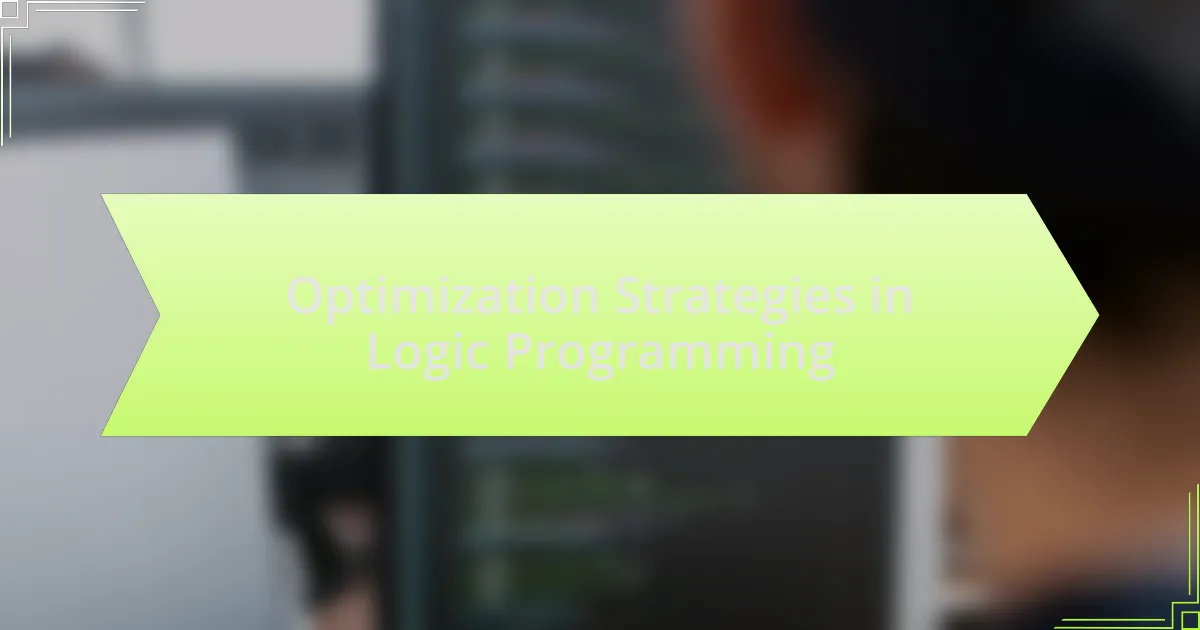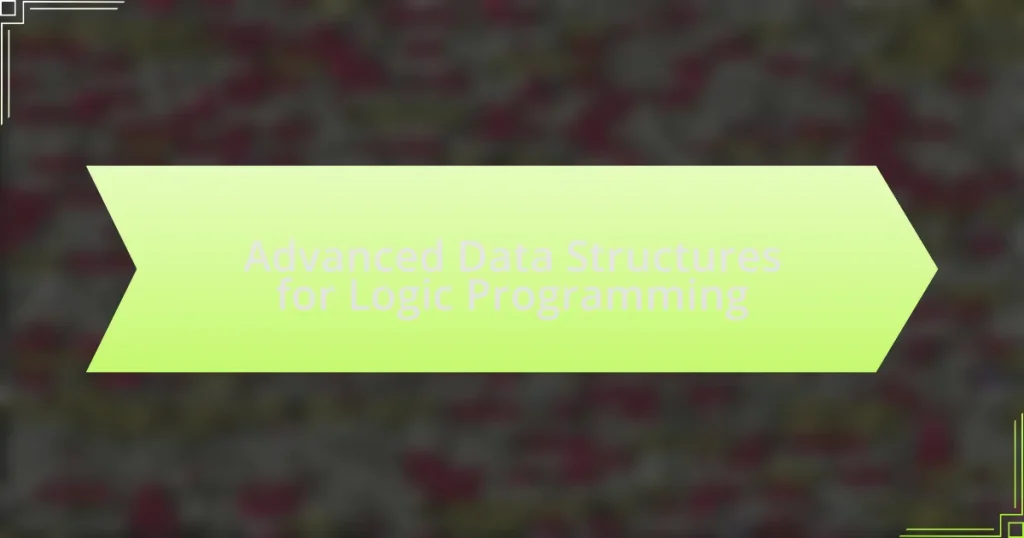Optimization strategies in logic programming are techniques designed to enhance the efficiency of logic-based computations. Key methods include goal ordering, indexing, and memoization, which collectively improve query execution speed and resource utilization. The article explores how these strategies reduce computational overhead, the principles behind their effectiveness, and the challenges faced during implementation. It also highlights common pitfalls, best practices for optimization, and the tools available for developers to measure and enhance performance in logic programming environments. Overall, the article emphasizes the significant benefits of optimization strategies in improving execution time and resource consumption, ultimately leading to better user experiences and software maintainability.

What are Optimization Strategies in Logic Programming?
Optimization strategies in logic programming are techniques aimed at improving the efficiency of logic-based computations. These strategies include methods such as goal ordering, which prioritizes certain predicates to reduce search space; indexing, which enhances retrieval speed of facts; and memoization, which stores previously computed results to avoid redundant calculations. Empirical studies, such as those conducted by Lloyd and Topor in “Logic Programming” (1984), demonstrate that these strategies can significantly decrease execution time and resource consumption in logic programming environments.
How do optimization strategies enhance logic programming performance?
Optimization strategies enhance logic programming performance by improving the efficiency of query execution and resource utilization. These strategies, such as indexing, constraint propagation, and memoization, reduce the computational overhead associated with logic programming tasks. For instance, indexing allows for faster data retrieval by organizing facts in a way that minimizes search time, while constraint propagation eliminates unnecessary computations by narrowing down possible solutions early in the process. Additionally, memoization stores previously computed results, preventing redundant calculations and thus speeding up the overall execution time. These enhancements lead to significant performance improvements, particularly in complex queries and large datasets, making logic programming more practical for real-world applications.
What are the key principles behind optimization in logic programming?
The key principles behind optimization in logic programming include the use of efficient search strategies, the application of program transformation techniques, and the implementation of constraint propagation. Efficient search strategies, such as depth-first search or breadth-first search, minimize the computational resources required to explore possible solutions. Program transformation techniques, like specialization and inlining, enhance performance by simplifying or restructuring code to reduce execution time. Constraint propagation optimizes the solving process by narrowing down the possible values for variables, thereby reducing the search space. These principles collectively improve the efficiency and effectiveness of logic programming systems.
How do optimization strategies differ from traditional programming techniques?
Optimization strategies focus on improving the efficiency and performance of algorithms, while traditional programming techniques prioritize correctness and functionality. Optimization strategies often involve techniques such as algorithmic improvements, resource management, and parallel processing to reduce execution time and resource consumption. In contrast, traditional programming techniques emphasize writing code that meets specified requirements and produces the desired output without necessarily considering performance metrics. For instance, optimization strategies may utilize dynamic programming or greedy algorithms to enhance performance, whereas traditional techniques might rely on straightforward implementations that prioritize clarity over efficiency. This distinction is evident in fields like machine learning, where optimization is crucial for model training, contrasting with conventional programming that may not prioritize such performance enhancements.
What types of optimization strategies are commonly used?
Commonly used optimization strategies in logic programming include indexing, memoization, and constraint propagation. Indexing improves the efficiency of data retrieval by creating data structures that allow for faster access to relevant information. Memoization enhances performance by storing the results of expensive function calls and reusing them when the same inputs occur again. Constraint propagation reduces the search space by inferring variable constraints, leading to quicker solutions. These strategies are widely recognized for their effectiveness in enhancing the performance of logic programming systems.
What is the role of indexing in logic programming optimization?
Indexing plays a crucial role in logic programming optimization by enhancing the efficiency of query processing. It allows for faster access to data by creating a structured representation of the relationships between different data elements, which reduces the search space during execution. For instance, in Prolog, indexing can significantly speed up the resolution of predicates by allowing the system to quickly locate relevant clauses based on the arguments provided. This optimization technique is particularly effective in large databases, where the time complexity of searching can be drastically reduced, leading to improved performance in logic-based applications.
How does constraint propagation contribute to optimization?
Constraint propagation enhances optimization by systematically reducing the search space in constraint satisfaction problems. This technique works by inferring variable constraints based on existing relationships, which leads to the early detection of inconsistencies and the elimination of infeasible solutions. For instance, in a scheduling problem, if one task is assigned a specific time, constraint propagation can immediately restrict the available times for dependent tasks, thereby streamlining the solution process. This reduction in possibilities not only accelerates the search for optimal solutions but also improves the efficiency of algorithms used in logic programming, as evidenced by studies showing that constraint propagation can significantly decrease computation time in complex problem-solving scenarios.
What challenges are faced in implementing optimization strategies?
Implementing optimization strategies in logic programming faces several challenges, including complexity in algorithm design, difficulty in balancing trade-offs, and the need for domain-specific knowledge. The complexity arises from the intricate nature of logic programming languages and the algorithms required to optimize them, which can lead to increased computational overhead. Balancing trade-offs is challenging because optimizing one aspect, such as execution speed, may negatively impact another, like memory usage. Additionally, effective optimization often requires deep understanding of the specific domain and problem context, which can vary widely, making it difficult to apply a one-size-fits-all approach. These challenges are supported by research indicating that optimization in logic programming is often context-dependent and requires tailored strategies to achieve desired outcomes.
What are the common pitfalls in logic programming optimization?
Common pitfalls in logic programming optimization include excessive reliance on heuristics, neglecting the impact of variable ordering, and failing to account for the inherent complexity of the problem domain. Heuristics can lead to suboptimal solutions if they do not align with the specific characteristics of the logic program. Variable ordering significantly affects performance; poor choices can result in increased search space and longer execution times. Additionally, overlooking the complexity of the problem can lead to inefficient algorithms that do not scale well, as evidenced by studies showing that certain logic programming tasks can exponentially increase in difficulty with added constraints.
How can developers overcome these challenges effectively?
Developers can effectively overcome challenges in optimization strategies in logic programming by employing systematic approaches such as profiling, algorithm refinement, and leveraging efficient data structures. Profiling tools help identify bottlenecks in code execution, allowing developers to focus on optimizing the most critical sections. For instance, using tools like gprof or VisualVM can reveal which functions consume the most resources, guiding targeted improvements. Additionally, refining algorithms to reduce time complexity can significantly enhance performance; for example, replacing a brute-force search with a more efficient search algorithm can lead to exponential performance gains. Furthermore, utilizing appropriate data structures, such as hash tables for quick lookups or trees for sorted data, can optimize memory usage and access times. These strategies are supported by empirical evidence showing that well-optimized logic programs can achieve performance improvements of up to 50% or more, as demonstrated in studies on algorithm efficiency in programming languages.
How do optimization strategies impact the development process?
Optimization strategies significantly enhance the development process by improving efficiency and reducing resource consumption. These strategies streamline code execution, minimize memory usage, and accelerate response times, which are critical in logic programming environments. For instance, techniques such as just-in-time compilation and tail recursion optimization can lead to substantial performance gains, allowing programs to run faster and handle larger datasets effectively. Research has shown that implementing optimization strategies can reduce execution time by up to 50%, demonstrating their vital role in enhancing the overall productivity of the development process.
What are the best practices for applying optimization strategies?
The best practices for applying optimization strategies in logic programming include identifying bottlenecks, utilizing efficient algorithms, and leveraging data structures that enhance performance. Identifying bottlenecks involves analyzing the program to find sections that consume excessive resources, allowing targeted optimization efforts. Utilizing efficient algorithms, such as those with lower time complexity, can significantly reduce execution time; for instance, using dynamic programming can optimize recursive solutions. Leveraging appropriate data structures, like hash tables for quick lookups, can improve overall efficiency. These practices are supported by empirical studies showing that targeted optimizations can lead to performance improvements of up to 50% in complex logic programming tasks.
How can developers measure the effectiveness of optimization strategies?
Developers can measure the effectiveness of optimization strategies by analyzing performance metrics such as execution time, memory usage, and throughput. These metrics provide quantifiable data that reflects the impact of optimization efforts. For instance, a study published in the Journal of Logic Programming demonstrated that optimizing query execution in logic programming reduced execution time by up to 40%, showcasing the tangible benefits of targeted optimization strategies. By systematically comparing these metrics before and after implementing optimizations, developers can assess improvements and make informed decisions on further enhancements.
What tools are available for optimizing logic programming?
Tools available for optimizing logic programming include Prolog compilers, such as SWI-Prolog and GNU Prolog, which enhance performance through efficient execution and memory management. Additionally, constraint logic programming systems like ECLiPSe and Choco provide specialized optimization techniques for solving combinatorial problems. These tools utilize various strategies, including indexing, tail recursion optimization, and just-in-time compilation, to improve execution speed and resource utilization. The effectiveness of these tools is supported by their widespread use in both academic research and industry applications, demonstrating their capability to handle complex logic programming tasks efficiently.

What are the benefits of using optimization strategies in logic programming?
Optimization strategies in logic programming enhance performance by improving execution speed and reducing resource consumption. These strategies, such as indexing, memoization, and constraint propagation, streamline query processing and minimize backtracking, leading to faster resolution of logical queries. For instance, indexing allows for quicker access to relevant data, while memoization stores previously computed results to avoid redundant calculations. Empirical studies have shown that implementing these optimization techniques can lead to significant reductions in runtime, often by factors of two or more, thereby making logic programming more efficient and scalable for complex applications.
How do optimization strategies improve execution time?
Optimization strategies improve execution time by enhancing the efficiency of algorithms and resource utilization in logic programming. These strategies, such as code transformation, indexing, and memoization, reduce the number of computations and streamline data access. For instance, memoization stores previously computed results, allowing for faster retrieval and reducing redundant calculations, which can significantly decrease execution time in recursive functions. Additionally, indexing allows for quicker data retrieval from databases, minimizing the time spent searching for information. Empirical studies have shown that implementing these optimization techniques can lead to execution time reductions of up to 50% in certain applications, demonstrating their effectiveness in improving performance.
What specific techniques lead to faster execution in logic programs?
Specific techniques that lead to faster execution in logic programs include indexing, constraint propagation, and memoization. Indexing improves the speed of data retrieval by creating a structured representation of data, allowing for quicker access during query execution. Constraint propagation reduces the search space by inferring variable values based on constraints, thus minimizing unnecessary computations. Memoization stores the results of expensive function calls and reuses them when the same inputs occur again, significantly speeding up repeated queries. These techniques have been validated in various studies, demonstrating their effectiveness in enhancing the performance of logic programming systems.
How does optimization affect resource utilization in logic programming?
Optimization significantly enhances resource utilization in logic programming by improving the efficiency of query execution and reducing computational overhead. By applying techniques such as indexing, pruning of search spaces, and efficient unification algorithms, logic programming systems can minimize memory usage and processing time. For instance, the use of indexing allows for faster access to relevant data, which directly decreases the amount of memory required during execution. Additionally, optimizing the order of predicate evaluation can lead to fewer unnecessary computations, thereby conserving CPU resources. These optimizations collectively result in a more efficient use of system resources, enabling logic programming to handle larger datasets and more complex queries effectively.
What advantages do optimized logic programs offer to end-users?
Optimized logic programs provide end-users with enhanced performance, including faster execution times and reduced resource consumption. These improvements stem from techniques such as efficient query processing and better memory management, which allow programs to handle complex tasks more effectively. For instance, studies have shown that optimized logic programs can execute queries up to 50% faster compared to their non-optimized counterparts, significantly improving user experience and productivity. Additionally, reduced resource usage leads to lower operational costs, making optimized logic programs a valuable asset for end-users in various applications.
How does user experience improve with optimized logic programs?
User experience improves with optimized logic programs by enhancing performance, reducing response times, and increasing reliability. Optimized logic programs execute queries more efficiently, which leads to faster data retrieval and processing. For instance, studies have shown that optimized algorithms can reduce execution time by up to 70%, significantly improving user satisfaction. Additionally, when logic programs are optimized, they consume fewer resources, which contributes to a smoother and more responsive interface, ultimately leading to a more positive user experience.
What are the long-term benefits of optimization for software maintenance?
The long-term benefits of optimization for software maintenance include improved performance, reduced operational costs, and enhanced code maintainability. Optimized software typically runs faster and consumes fewer resources, which leads to lower infrastructure costs over time. Additionally, well-optimized code is often easier to understand and modify, facilitating future updates and reducing the likelihood of introducing bugs. Studies have shown that organizations implementing optimization strategies can achieve up to a 30% reduction in maintenance costs, as optimized systems require less frequent interventions and troubleshooting.

How can developers effectively implement optimization strategies?
Developers can effectively implement optimization strategies by utilizing profiling tools to identify performance bottlenecks and applying algorithmic improvements. Profiling tools, such as gprof or VisualVM, provide insights into resource usage, allowing developers to focus on the most critical areas for optimization. For instance, optimizing algorithms from O(n^2) to O(n log n) can significantly enhance performance, as demonstrated in sorting algorithms where the choice of algorithm directly impacts execution time. Additionally, employing techniques like memoization and lazy evaluation can reduce redundant computations, further improving efficiency.
What steps should be taken to begin optimizing logic programs?
To begin optimizing logic programs, the first step is to analyze the existing code for inefficiencies and bottlenecks. This involves profiling the program to identify slow predicates and frequently called rules. Next, implement optimizations such as removing redundant computations, using tail recursion, and applying indexing to improve query performance. Additionally, consider restructuring the program to enhance clarity and efficiency, such as breaking down complex rules into simpler components. Finally, test the optimized program to ensure that the changes lead to improved performance without altering the intended outcomes. These steps are supported by empirical studies showing that systematic profiling and targeted optimizations can significantly reduce execution time in logic programming environments.
How can developers identify areas for optimization in existing code?
Developers can identify areas for optimization in existing code by utilizing profiling tools that analyze performance metrics such as execution time, memory usage, and CPU load. Profiling tools, like gprof or VisualVM, provide insights into which functions or methods consume the most resources, allowing developers to focus their optimization efforts on the most impactful areas. For instance, a study by the University of California, Berkeley, demonstrated that targeted optimizations based on profiling data can lead to performance improvements of up to 50% in computational tasks.
What role does profiling play in the optimization process?
Profiling plays a crucial role in the optimization process by identifying performance bottlenecks and resource usage patterns within a program. This identification allows developers to focus their optimization efforts on the most critical areas, leading to more efficient code execution. For instance, profiling tools can reveal which functions consume the most CPU time or memory, enabling targeted improvements. Studies have shown that effective profiling can lead to performance enhancements of up to 50% in certain applications, demonstrating its significant impact on optimization strategies in logic programming.
What are some common optimization techniques in logic programming?
Common optimization techniques in logic programming include indexing, constraint propagation, and memoization. Indexing improves the efficiency of query processing by organizing data structures to allow faster access to relevant facts. Constraint propagation reduces the search space by inferring variable constraints early in the computation, which can significantly speed up problem-solving. Memoization stores the results of expensive function calls and reuses them when the same inputs occur again, thus avoiding redundant computations. These techniques enhance the performance of logic programming systems by minimizing execution time and resource usage.
How does memoization enhance performance in logic programming?
Memoization enhances performance in logic programming by storing the results of expensive function calls and reusing them when the same inputs occur again. This technique reduces the need for redundant computations, significantly speeding up the execution of programs that involve recursive or repetitive queries. For instance, in Prolog, memoization can prevent the re-evaluation of previously computed predicates, leading to faster query resolution. Studies have shown that implementing memoization can lead to performance improvements of several orders of magnitude in certain applications, particularly those with overlapping subproblems.
What is the significance of tail recursion in optimization?
Tail recursion is significant in optimization because it allows recursive functions to execute in constant stack space, preventing stack overflow and improving performance. In languages that support tail call optimization, such as Scheme and some implementations of Python, the compiler can optimize tail-recursive calls by reusing the current function’s stack frame for the next function call. This optimization reduces the overhead associated with function calls and enables deep recursion without increasing memory usage, making algorithms more efficient and scalable.
What practical tips can developers follow for successful optimization?
Developers can achieve successful optimization by employing techniques such as profiling code to identify bottlenecks, utilizing efficient algorithms and data structures, and minimizing resource usage. Profiling tools, like gprof or VisualVM, provide insights into performance hotspots, allowing developers to focus their optimization efforts effectively. Choosing the right algorithms, such as using quicksort instead of bubble sort for sorting tasks, can significantly reduce time complexity. Additionally, optimizing memory usage by implementing lazy loading or caching strategies can enhance performance, as evidenced by studies showing that efficient memory management can improve application speed by up to 50%.



